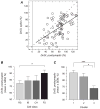Lack of orientation and direction selectivity in a subgroup of fast-spiking inhibitory interneurons: cellular and synaptic mechanisms and comparison with other electrophysiological cell types
- PMID: 17720684
- PMCID: PMC3136126
- DOI: 10.1093/cercor/bhm137
Lack of orientation and direction selectivity in a subgroup of fast-spiking inhibitory interneurons: cellular and synaptic mechanisms and comparison with other electrophysiological cell types
Erratum in
- Cereb Cortex. 2008 Nov;18(11):2717
Abstract
Neurons in cat area 17 can be grouped in 4 different electrophysiological cell classes (regular spiking, intrinsically bursting, chattering, and fast spiking [FS]). However, little is known of the functional properties of these different cell classes. Here we compared orientation and direction selectivity between these cell classes in cat area 17 and found that a subset of FS inhibitory neurons, usually with complex receptive fields, exhibited little selectivity in comparison with other cell types. Differences in occurrence and amplitude of gamma-range membrane fluctuations, as well as in numbers of action potentials in response to optimal visual stimuli, did not parallel differences observed for orientation and direction selectivity. Instead, differences in selectivity resulted mostly from differences in tuning of the membrane potential responses, although variations in spike threshold also contributed: weakly selective FS neurons exhibited both a lower spike threshold and more broadly tuned membrane potential responses in comparison with the other cell classes. Our results are consistent with the hypothesis that a subgroup of FS neurons receives connections and possesses intrinsic properties allowing the generation of weakly selective responses. The existence of weakly selective inhibitory neurons is consistent with orientation selectivity models that rely on broadly tuned inhibition.
Conflict of interest statement
Figures













Similar articles
-
Synaptic Basis for Differential Orientation Selectivity between Complex and Simple Cells in Mouse Visual Cortex.J Neurosci. 2015 Aug 5;35(31):11081-93. doi: 10.1523/JNEUROSCI.5246-14.2015. J Neurosci. 2015. PMID: 26245969 Free PMC article.
-
Orientation selectivity of synaptic input to neurons in mouse and cat primary visual cortex.J Neurosci. 2011 Aug 24;31(34):12339-50. doi: 10.1523/JNEUROSCI.2039-11.2011. J Neurosci. 2011. PMID: 21865476 Free PMC article.
-
Stimulus feature selectivity in excitatory and inhibitory neurons in primary visual cortex.J Neurosci. 2007 Sep 26;27(39):10333-44. doi: 10.1523/JNEUROSCI.1692-07.2007. J Neurosci. 2007. PMID: 17898205 Free PMC article.
-
Directional inhibition: a new slant on an old question.Neuron. 2005 Jan 6;45(1):5-7. doi: 10.1016/j.neuron.2004.12.029. Neuron. 2005. PMID: 15629696 Review.
-
[Mechanisms of orientation selectivity of simple and complex neurons in the visual cortex and a model of the orientation-selective receptive field].Usp Fiziol Nauk. 1984 Oct-Dec;15(4):23-45. Usp Fiziol Nauk. 1984. PMID: 6095554 Review. Russian. No abstract available.
Cited by
-
Distinguishing externally from saccade-induced motion in visual cortex.Nature. 2022 Oct;610(7930):135-142. doi: 10.1038/s41586-022-05196-w. Epub 2022 Sep 14. Nature. 2022. PMID: 36104560 Free PMC article.
-
Local circuit inhibition in the cerebral cortex as the source of gain control and untuned suppression.Neural Netw. 2013 Jan;37:172-81. doi: 10.1016/j.neunet.2012.09.005. Epub 2012 Sep 20. Neural Netw. 2013. PMID: 23036513 Free PMC article.
-
Contrast adaptation contributes to contrast-invariance of orientation tuning of primate V1 cells.PLoS One. 2009;4(3):e4781. doi: 10.1371/journal.pone.0004781. Epub 2009 Mar 10. PLoS One. 2009. PMID: 19274097 Free PMC article.
-
Response Properties of Interneurons and Pyramidal Neurons in Macaque MSTd and VPS Areas During Self-Motion.Front Neural Circuits. 2018 Nov 23;12:105. doi: 10.3389/fncir.2018.00105. eCollection 2018. Front Neural Circuits. 2018. PMID: 30532695 Free PMC article.
-
Effects of electrical coupling among layer 4 inhibitory interneurons on contrast-invariant orientation tuning.Exp Brain Res. 2011 Jan;208(1):127-38. doi: 10.1007/s00221-010-2483-0. Epub 2010 Nov 11. Exp Brain Res. 2011. PMID: 21069305
References
-
- Adelson EH, Bergen JR. Spatiotemporal energy models for the perception of motion. J Opt Soc Am A. 1985;2:284–299. - PubMed
-
- Ahmed B, Anderson JC, Martin KAC, Nelson JC. Map of the synapses onto layer 4 basket cells of the primary visual cortex of the cat. J Comp Neurol. 1997;380:230–242. - PubMed
-
- Albrecht DG, Geisler WS. Motion selectivity and the contrast-response function of simple cells in the visual cortex. Vis Neurosci. 1991;7:531–546. - PubMed
-
- Albus K. A quantitative study of the projection area of the central and the paracentral visual field in area 17 of the cat. II. The spatial organization of the orientation domain. Exp Brain Res. 1975;24:181–202. - PubMed
-
- Anderson JS, Lampl I, Gillespie DC, Ferster D. The contribution of noise to contrast invariance of orientation tuning in cat visual cortex. Science. 2000;290:1968–1972. - PubMed
Publication types
MeSH terms
Grants and funding
LinkOut - more resources
Full Text Sources
Molecular Biology Databases
Miscellaneous

